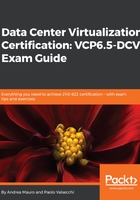
Configuring FC/iSCSI/FCoE LUNs as ESXi boot devices
Boot from SAN is an option so that you can have diskless ESXi hosts, and it's supported for FC, FCoE, and (with some limitations) iSCSI storage arrays.
There are some requirements, as follows:
- Each host must have access to its own dedicated boot LUN and should be the first LUN ID (usually 0). Multiple servers can share a diagnostic partition. You can use array-specific LUN masking to achieve this configuration.
- Enable boot both at host BIOS level and the SAN adapter (depending on the type of SAN).
- Multipathing to a boot LUN on active-passive arrays is not supported because the BIOS does not support multipathing and is unable to activate a standby path.
The configuration of the adapter varies from the type of adapter (for example, Emulex or Qlogic) enable and correctly configure the HBA, so it can access the boot LUN.
For FCoE boot from SAN (introduced in vSphere 5.1), you perform most configurations through the option ROM of the network adapter. The network adapters must support one of the following formats, which communicate parameters about an FCoE boot device to VMkernel:
- FCoE Boot Firmware Table (FBFT): Intel propriety
- FCoE Boot Parameter Table (FBPT): Defined by VMware for third-party vendors to implement a software FCoE boot
Note that, with FCoE, you have the following additional limitations:
- You cannot change software FCoE boot configuration from within ESXi
- Coredump is not supported on any software FCoE LUNs, including the boot LUN
- Multipathing is not supported at pre-boot
- If you are using an Intel 10Gb controller with a Cisco switch, configure the switch port to enable spanning tree (STP) and to turn off switchport trunk native vlan
For iSCSI, there are other additional considerations, depending also on the type of the iSCSI initiator (discussed later).
For independent iSCSI adapters, just refer to the specific HBA vendor guide.
For software-dependent iSCSI adapters, you need a NIC that supports the iSCSI Boot Firmware Table (iBFT) format. In this case, you can configure the networking and iSCSI boot parameters on the network adapter and enable the adapter for the iSCSI boot.
For more information, see the following vSphere 6.5 Storage guides:
- Booting ESXi from Fibre Channel SAN (https://docs.vmware.com/en/VMware-vSphere/6.5/com.vmware.vsphere.storage.doc/GUID-9004389B-E2C0-4BE5-811C-E4886E3B7450.html)
- Booting ESXi with Software FCoE (https://docs.vmware.com/en/VMware-vSphere/6.5/com.vmware.vsphere.storage.doc/GUID-C1FD30A2-27C1-45A6-A736-E0AE76A0ADB2.html)
- Booting from iSCSI SAN (https://docs.vmware.com/en/VMware-vSphere/6.5/com.vmware.vsphere.storage.doc/GUID-2A66A330-A9E5-460B-8982-54A1B1C38C02.html)